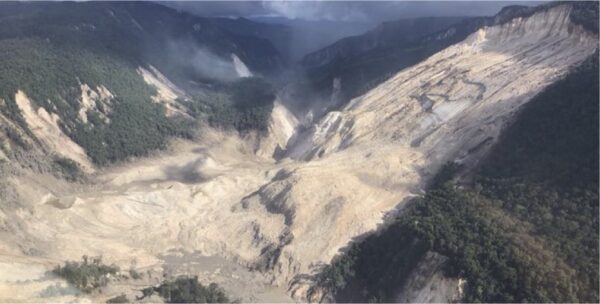Formation
Deeply buried carbonate platforms and their adjacent slope deposits are a focus of petroleum exploration around the world because of their reservoir qualities, with 50-60 per cent of global hydrocarbon production flowing from these rock types.
During the Miocene (12-22 million years ago), the island of New Ireland was a continuous chain of coral reefs that extended for over 300 kilometres. Although the volcanic island that the reefs were built upon was constantly sinking due to basinal subsidence, the reefs happily kept growing until they built up a thickness of up to 1,000 metres (Lelet Limestone). In total, the chain of reefs formed an elongate carbonate platform.
But the New Ireland reefal sediments did not get buried in a conventional way, because around 12 million years ago, they were tectonically uplifted to form a mountain range over 2,000 metres above sea level.
The over-steepened carbonate slopes were prone to collapse failure during earthquakes. The modern New Ireland coastline shows evidence for multiple slope failure events, where large blocks of the uplifted carbonate platform collapsed into the ocean. The collapse events delivered massive volumes of carbonate rock debris into the offshore deepwater areas.
PEAK discovered multiple debris flow units in the New Ireland Basin during a 2017 2D seismic campaign, with the largest being the Exotica carbonate debrite, measuring 45 kilometres in length, 32 kilometres in width and with thickness up to 400 metres.
As this formation is likely made up of broken up reef sediments and has high measured porosity and permeability, it constitutes what is known in the industry as a ‘deep-water resedimented slope carbonate play.’
Resedimented slope carbonate deposits are a new petroleum play type in Papua New Guinea. They are known to make excellent hydrocarbon reservoirs in Southeast Asia, Kazakhstan and the Gulf of Mexico; for example:
- Tengiz, Kazakhstan (19 km x 21 km; 6 BBOE (billion barrels of oil equivalent).
- Poza Rica, Mexico (30 km x 10 km; 2.9 BBOE).
Brent I.A. McInnes and Timothy F. McConachy, 2020. The Exotica Carbonate Debrite Formation: A Potential Source for Thermogenic Hydrocarbon Seeps Offshore New Ireland, New Ireland Basin, Papua New Guinea. In 1st AAPG/EAGE PNG Geoscience Conference & Exhibition, “PNG’s Oil and Gas Industry Maturing Through Exploration, Development And Production”
25-27 February 2020, Port Moresby, Papua New Guinea.
> View Article
Brent I.A. McInnes, Michael Nongkas, Harvey Cook, Kai Rankenburg, Noreen J. Evans, Brad J. McDonald and MD Zakaria Quadir, 2020.Tube Fossils in the Lelet Formation, New Ireland: Evidence for Miocene Hydrocarbon Seepage in the New Ireland Basin? In 1st AAPG/EAGE PNG Geoscience Conference & Exhibition, “PNG’s Oil and Gas Industry Maturing Through Exploration, Development And Production”
25-27 February 2020, Port Moresby, Papua New Guinea.
> View Article

